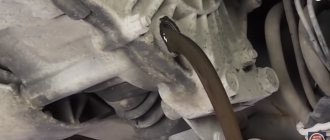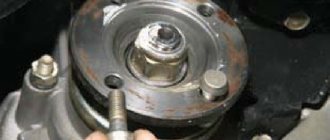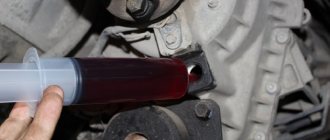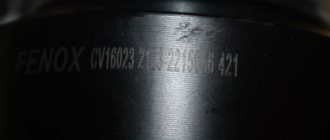A motor is a component of a car, the performance of which is the basis for the functioning of the car. Operating any vehicle involves not only driving the car, but also its proper maintenance, which includes a number of routine procedures, the most important of which is the timely change of oil in the power unit. In this article we will tell you how important it is to change the oil in a Chevrolet Niva engine, which is purchased by drivers by default for operation in severe or moderate off-road conditions, we will consider the features of selecting an oil, the optimal frequency of procedures and the specifics of doing this task yourself.
Instructions for changing engine oil in Niva Chevrolet.
Engine oil change interval
The frequency of changing the oil in the internal combustion engine of an SUV is the first question that the owner of a Niva must decide on. The difficulty of the solution lies in the fact that, on the one hand, extreme operating conditions and engine loads imply frequent changes of working fluids, on the other hand, the Niva is an SUV, which by default must be ready for difficult conditions. An unambiguous answer to the question that interests owners, how often an oil change is needed in a Niva Chevrolet engine, is given by the automaker’s regulations, according to which the interval between procedures should not exceed one year, even if the car is used in a gentle mode, or after every fifteen thousand kilometers the car has traveled.
Additionally, the following factors of the negative category may influence the interval between oil changes on the Chevrolet Niva towards reduction:
- Filling a car with low-quality fuel with an excessive sulfur content or other deviations of the filling fluid from the established standards.
- Predominant operation of the machine in difficult conditions, which experts include increased loads on the engine during low-speed driving and increased air pollution, which is most often observed in large cities.
- Intensive use of transport all year round, which is accompanied by sudden changes in temperature conditions, increased air humidity in the autumn and spring, which contribute to a faster loss of the oil’s declared qualities.
An indicator of the need for an unscheduled oil change may be deteriorated machine performance or extraneous noise from the engine. You can also determine the need to change the engine oil by visually inspecting the lubricant in the system during a scheduled or extraordinary check of its level. Indicators for replacing the lubricant in this case may include impurities in the lubricant, a change in its color to a black tint, or a burning smell. Having made sure that the oil needs to be changed, the Niva owner, before starting work, needs to buy the lubricant itself. And to do this, it’s worth figuring out which motor oil is best suited for the unit and how much it will be needed for a complete replacement.
Types of oils
Mineral
This product is obtained by processing (refining) the crude oil that appears during the distillation of petroleum. In the subsequent preparation process, mineral oils are mixed with various additives that improve the viscosity of the material and the wear-resistant qualities of the lubricating fluid. Mineral oils are available at a price equivalent, but their use in pure form is decreasing every year. The reason is low performance characteristics . At high temperatures, mineral oil burns out, which reduces the quality of the lubricating effect. This means increased wear of engine parts, deterioration of engine performance, excessive fuel consumption and many other unpleasant consequences.
Synthetic
Lubricating fluids of this type are produced through complex chemical processes. They are distinguished by heat resistance and long-term preservation of viscosity qualities. Additives added to synthetics help improve the lubricating characteristics of the fluid, which reduces wear on the piston group and other engine parts that come into contact during friction. These parameters qualitatively affect the operating time of the entire power unit.
Another advantage of synthetic oils is that it has greater fluidity, which is very important in cold weather, since the lubricant does not thicken, and the car engine starts and runs easier.
Semi-synthetic
This type includes lubricating fluids of a mixed nature, that is, semi-synthetics contain from 70 to 80 percent mineral oil and from 20 to 30 percent synthetic oil.
Which oil is preferable to fill?
When selecting motor oil for a car’s power unit, the owner must understand that not only the period between replacements, but also the operational criteria of the internal combustion engine will depend on the quality of the liquid filled. All this leads to the fact that when choosing a lubricant, you should not save, as this is often impractical. The internal combustion engine of the Chevrolet Niva, according to the manufacturer's regulations, is a high-tech unit and meets the Euro-4 standard, which means filling with oil based on synthetic materials of the appropriate quality. From the factory, the Niva Chevrolet engine is filled with motor oil with a viscosity coefficient of 5W30, which meets ACEA class A2 and API standard SL/CF criteria.
Accordingly, when choosing a replacement engine oil, it is necessary to give preference to products with quality standards declared by the automaker, while the viscosity coefficient may vary depending on the prevailing operating conditions of the vehicle and the temperature range in which it is used. API acceptable criteria for filling into internal combustion engines are the oil markings SG, SH and SJ. As for the priority brand of products, car owners most often use oil from Lukoil, Shell and Mobile for filling. However, the consumer can give preference to any of the world’s well-established suppliers of lubricants and combustible materials, choosing from their assortment a product with quality criteria that meets the standards described above.
When purchasing oil, it is important to take a responsible approach to choosing a point of sale; certified auto stores are preferred, as they protect the consumer as much as possible from purchasing counterfeit products.
Engine oil performance tables
Table 1. Comparative characteristics of mineral water and synthetics
Comparative characteristics of mineral and synthetic oils
Table 2. Recommendations for the use of oils with different temperature operating conditions of the engine
| Max ambient temperature | Viscosity according to SAE J 300 | Min t°С cold start of the engine |
| 25 | 0W-30 | < -35 |
| 30 | 0W-40 | < -35 |
| 25 | 5W-30 | -30 |
| 35 | 5W-40 | -30 |
| 25 | 10W-30 | -25 |
| 35 | 10W-40 | -25 |
| 45 | 15W-40 | -20 |
| 45 | 20W-40 | -10 |
Volume of motor fluid in the internal combustion engine system
To determine how much oil you need to buy to completely replace it in a Chevrolet Niva engine, it is important to know the engine size of the vehicle you are using. The Chevrolet Niva model can be modified with two variations of power units: the first is a basic 1.7 petrol engine with a power rating of eighty horsepower, the other is an alternative option installed under an Opel license, with a 1.8 rating and one hundred and twenty-five horsepower units. . The amount of oil in the Chevrolet Niva 1.7 and 1.8 engines is 3.75 and 4.75 liters, respectively. In both cases, it would be prudent to buy a five-liter canister of oil: the remainder can be used as a strategic reserve in case of need for topping up during operation of the SUV.
Reservoir for windshield and brake fluid.
Another filling capacity of the Chevrolet Niva is two glass washer reservoirs, the capacity of which is five and two liters.
This model has two independent braking systems. The working one has a hydraulic drive, the parking one has a mechanical drive. The contours are separated from each other.
The hydraulic drive includes a special tank made for brake fluid.
- DOT-4 brake fluid is suitable for half-liter hydraulic brakes. The product has improved characteristics and has a boiling point of over 235 degrees. Well suited for regions with low ambient temperatures.
- SAEJ1703, FMSS116 are used for the entire hydraulic system and clutch release (0.15 l). The synthetic product provides good lubrication and reduces oxidation at high temperatures.
- The tank lid hatch hinges, door and hood locks require VTV-1 and FIOL-1 greases. Hinges of steering rods and cardan shafts - ShRB-4, Litin 2, Esma.
- The air conditioner also has two tanks. One of them is for oil (0.22 l), the other is for refrigerant (0.650 kg).
Chevrolet Niva reservoirs for refilling liquids and lubricants are quite reliable and convenient when you need to make a replacement.
Various tags and sensors make it possible to carry out control almost immediately, which allows you to avoid an emergency situation.
Preparing for replacement
In addition to purchasing oil in sufficient quantities, before you begin to change it yourself, it is important to prepare all the materials and tools necessary for this procedure. In parallel with replacing the lubricant in the internal combustion engine, according to the regulations, a change of the filter element is required. This consumable part must be purchased exclusively of the original type to ensure reliable filtration during engine operation. Depending on the modification of the internal combustion engine, different oil filters will be required, therefore this element must be selected exclusively in accordance with the information in the technical data sheet, according to the original Niva Chevrolet consumables catalog. It is advisable to make such a purchase at official points of sale.
Additionally, to perform the work you will need the following tools:
- a set of car keys;
- special wrench for unscrewing the oil filter;
- extension for keys;
- container for waste liquid;
- clean rags.
You will have to work on a warm engine, so prepare protective clothing.
Oil selection table by season (winter, summer)
| Year | Viscosity SAE all season from +25 to -25 °C | winter from -35 to 0 °C | summer from 0 to +35 °C |
| 5W-30 5W-40 | 20W-40 20W-30 25W-30 |
| 5W-30 5W-40 | 20W-40 20W-30 25W-30 |
| 5W-20 5W-30 5W-40 | 20W-40 20W-30 25W-30 25W-40 |
| 5W-20 5W-30 5W-40 | 20W-40 20W-30 25W-30 25W-40 |
The process of changing the oil
Changing the oil in a Chevrolet Niva engine, regardless of the modification of the unit, is carried out according to identical regulations, which are not characterized by any particular difficulties in its implementation, which allows you to perform this procedure in a garage with your own hands.
The success of the procedure for changing the oil in a Chevrolet Niva engine is ensured by following step-by-step instructions from the manufacturer:
- Warm up the car to operating temperatures so that the oil in the engine acquires a more fluid consistency, due to which the waste will be drained with maximum efficiency.
- Provide yourself with access to the front of the vehicle's underbody by mounting it on a pit or overpass.
- Before you start draining the waste, unscrew the oil filler plug - this will ensure a direct flow of liquid when draining it.
- The next step is draining the waste. To do this, you will need to remove the engine crankcase protective element and the mudguard, thoroughly clean the pan and the area near the oil drain opening so that when performing the procedure, dirt particles do not enter the system.
- Carefully unscrew the drain cap, having first placed under the hole a container for working out a displacement of at least four liters when modifying a 1.7 engine, and a five-liter container if you are draining the liquid from a 1.8 unit. Be very careful - very hot liquid will flow out.
- It will take about fifteen minutes to drain the liquid. During this time, clean the plug from possible accumulations and metal shavings. Pay attention to the O-ring - if it is deformed, replace it with a new part.
- After the liquid has completely drained from the system, you can begin to replace the filter element. To dismantle it you will need a special key. Before installing it in its original place, pour a little more than half of its volume of oil into the new filter, and also treat the sealing elements with the emulsion being poured. The filter is installed in its original place without any special tools; this can be done by hand.
- Close the oil drain cap and begin the process of filling in new oil.
- At the stage of pouring motor oil into the Chevrolet Niva engine, certain difficulties may arise, which can be solved by slowness and consistency in work. The main question of how much oil to pour into the engine so that excess oil does not have to be drained from the system is solved by pouring liquid into the unit in portions. First, fill in about three liters of lubricant and check the level with a dipstick. Then add oil in small portions, regularly checking the level. The norm is considered to be the car oil criterion on the dipstick, located in the center between the MIN and MAX marks, however, when filling the system when changing the lubricant, it must be topped up to the maximum maximum value. During operation, the oil will be distributed among the units of the unit, which will lead to a decrease in the level.
- Tighten the plug and start the engine, let it idle for a while. If the procedure is performed correctly, the oil pressure indicator should go out a few seconds after the engine is turned on.
- The final stage of work is to check the fluid level in the engine again, if necessary, top it up to the standard criteria, inspect the joints for leaks, tighten the filter and oil filler plug, and install the removed elements in their places.
At this point, the oil change job can be considered completed. Write down your mileage so you don't miss the next time you need to service the unit.
Determining the level
Before refueling, it is recommended to determine the oil level in the car:
1. Open the hood and find the inspection hole - there you will see a dipstick for measuring the oil level in the engine (it is located in the middle of the cylinder block on the breather cover of the crankcase ventilation system);
2. Remove the dipstick and wipe it with a cloth to remove any remaining oil;
3. Insert the dipstick back, and after 5-10 seconds, remove it again - normally the oil should be between o and “MAX”.
Let's sum it up
Changing engine oil is a mandatory ritual for the car owner, the performance and operational life of the car as a whole depend on the timeliness of which and the quality of the work performed. Changing the oil in a Chevrolet Niva does not differ in execution technology from a similar procedure on other brands of cars, therefore the implementation of this task never causes difficulties for “experienced” drivers. Beginners who do not have technical experience can contact a service center to perform maintenance, or, if they are confident in their abilities, thanks to perseverance and detailed instructions, they can complete this task themselves and save their budget. At the same time, purchase only high-quality motor oils - saving on the quality of lubricants is not rational.











